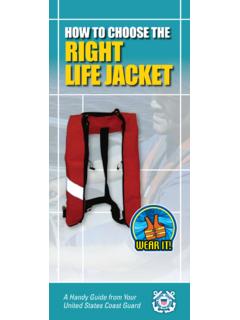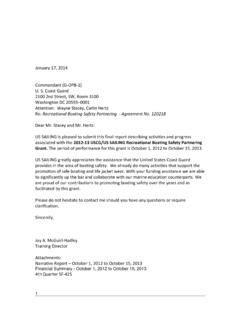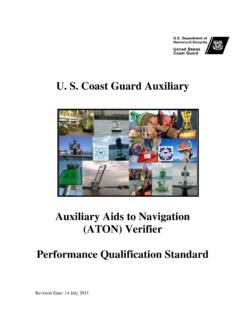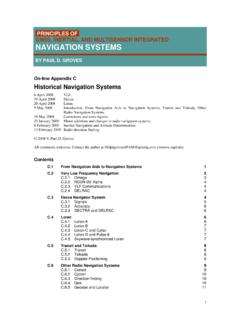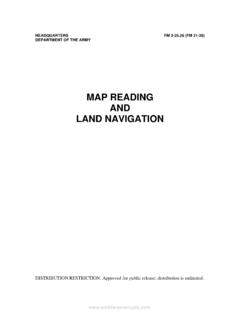Transcription of What You Need to Know About the Markers on the Water
1 aids to navigation SystemWhat You Need to know About the Markers on the WaterA Handy Guide from the United States Coast aids to navigation aids to navigation SystemAids to navigation can provide a boater with information similar to that which drivers get from street signs, stop signals, road barri-ers, detours, and traffic booklet will give you, the recreational boater, the basic information you need About the aids to navigation System (USATONS). This information will help you recognize, understand, and navigate by the colors, shapes, numbers, and lights you will encounter on the Water .
2 It will also give you the basic tools you need to read a nautical chart. In addition, you will find information on safety, the proper way to interact with other ves-sels, tips on boating at night, and how to handle special situations you might encounter, like bridges and some time to review this booklet, and keep it onboard your boat as a quick refer-ence. Your understanding of the Markers you see on the Water will help ensure that you, your family, and your friends have fun and safe boating trips. Best Regards, United States Coast Guard Boating Safety DivisionSTOPRead This Safe on the TO navigation ARETHE WATERWAYS ROAD SIGNSMost boating accidents are preventable!
3 Be sure to:Boaters call navigation rules the basic laws governing the steering or sailing of a boat The Rules of the Road. The Rules of the Road define the roles and responsibilities of vessel operators. If all operators obeyed these rules, most accidents could be avoided. One of the reasons the Rules of the Road exist is to keep boats from colliding with each other and with other objects. Since collisions are the number one type of accident on the Water , boaters should remember the following Rules of the a lookout. Designate someone to watch for dangers that may come from any direction.
4 Maintain a safe speed. Except where speed is restricted by regulation or the waterway is marked by a No Wake or Slow Speed Aid, you must judge safe speed for yourself, taking into account visibility, vessel traffic, your boat s ability to maneuver, and the weather a collision. The Rules of the Road include the actions to take when encountering another vessel on the Water . Some of the most common situations you may encounter are: overtaking, meeting head on, and crossing the bow of another vessel. In each case, the boat designated as the give-way vessel is required to yield to the other boat, while the boat designated as the stand-on vessel should maintain its course and speed.
5 The Rules vary slightly depending on whether you are boating on inland or on international waters. As an example, when operating on inland waters, sound signals are signals of intent; when operating on international waters, they are signals of action. Always wear your life jacket and require the same of your passengers Never boat under the influence Take a boating safety course Get a free Vessel Safety Check1. navigation RulES (RUleS of THe RoAd) aids to navigation aids to navigation System2 short blasts(1 )1 short blast(1 )2 short blasts(1 )1 short blast(1 )Stand-on VesselOvertakenGive-way VesselOvertaking(keep clear)Overtaking Situation ( navigation Rule 13)Head-On Situation ( navigation Rule 14)Port-to-Port Passing (preferred)Action(s): The give-way vessel (bottom) can pass on either side of the stand-on vessel (top).
6 Sound signals, inland: Passing portside requires two short (1-second) blasts on the horn signaling the overtaking boat s intention, and two short blasts for the stand-on vessel s agreement. Passing to starboard requires one short blast for intent and signals, international: Passing portside requires two prolonged (4-6 seconds) and two short blasts for the overtaking boat s intention, two short blasts for the stand-on vessel s agreement. Passing to starboard requires two prolonged and one short blast for intention. An agreement signal is only required when operating in a narrow channel or fairway; then the following blast pattern signals your agreement: one prolonged/one short/one prolonged/one short.
7 1 short blast (1 sec.)1 short blast (1 sec.)Action(s): When meeting another vessel head on, a port-to-port passing is preferred. Passing starboard-to-starboard is acceptable when necessary. Sound signals: Passing port-to-port requires one short horn blast to signal intention and one short blast for agreement. Passing to starboard requires two short blasts from each short blasts(1 sec. each)2 short blasts(1 sec. each)1 short blast(1 sec.)1 short blast (1 sec.)2 short blasts (1 sec. each)2 short blasts (1 sec. each)1 short blast (1 sec.)1 short blast(1 sec.)Stand-On VesselOvertakenGive-Way VesselOvertaking(keep clear)Starboard-to-Starboard aids to navigation aids to navigation Systemcrossing Situation ( navigation Rule 15)Action(s): In a crossing situation, the give-way vessel must act to avoid a collision.
8 This may include altering its course to pass astern of the stand-on vessel or slowing down. The stand-on vessel should maintain its course and speed. Sound signals, inland: The give-way vessel signals the stand-on vessel with one short horn blast. The stand-on vessel agrees with one short horn blast. Sound signals, international: The give-way vessel signals the stand-on vessel with one short horn blast. No agreement signal by the stand-on vessel is is much more to the navigation Rules than can be covered here. for more information, go to or meeting another boat, make early and substantial changes to your course.
9 This helps the other operator understand your two main types of aids to navigation are buoys and are aids that float on top of the Water , but are moored to the bottom of the body of Water . Some have a light affixed to the top; some do not. A buoy with a cylin-drical shape and a conical top is referred to as a nun. A buoy with a cylindrical shape and a flat top is called a can. Beacons are aids that are permanently fixed, most commonly to the bottom of a body of Water . A beacon that has a light attached is simply referred to as a light ; a beacon without a light attached is called a daybeacon.
10 Both buoys and beacons can provide a variety of navigation information via shape, color, light, and/or audible signal. Dayboards are informational term topmark refers to a non-lighting element, such as a sphere, that may be affixed to the top of an THE ESSENTIAl Markers : On the Water and On the chartsR "2A"GC "5A"FI R 4s30ft 6M "4"RGN "CF"R "4"Q RFI G 4s 15ft 5M "5"Red lIGHTed BUoYRed: always even numbersRed lIGHTGReeN CAN BUoYGreen: always odd numbersGReeN lIGHTRed/GReeN NUN BUoYRed dAYBeACoNGive-Way Vesselshould alter course to pass astern (behind)1 short blast (1 sec.)Stand-On Vesselshould maintain its course and speed1 short blast (1 sec.)
